Here are some fall scenes from a this week's trip by jet boat up the Clearwater River east of Fort McMurray, in NE Alberta... as I mentioned in another thread, there has not even been a frost up there yet, in this very mild autumn!
Stiff club-moss, Lycopodium annotinum:
I love these little forest-floor scenes! I was going to say that the moss coating this log was sphagnum, until I looked closer and compared to Mosses, Lichens and Ferns of Northwest North America (Vitt, Marsh, Bovey) - an excellent book for the interested amateur!... it seems to be Thuidium recognitum(?), with stiff club-moss:
Riverbank outcrops of thinly bedded Devonian limestone:
(P. S. I'll work on adding some captions to these later... :))
Comments
Re: Fall Colour in the North
Nice views! Obviously a lot of overlap with here, vegetatively, but some other things we don't have at all- looking forward to the captions! The rock outcropping is great, something else we don't have- love the ferns too- I've never seen any of those rock ferns in person- a couple of woodland species have shown up on the farm in recent years- I guess since grazing/trampling has been reduced, but different from these..
It seems they've been dry up there the last few years, opposite of here, but I think maybe they got a bit caught up in later summer this year..
Re: Fall Colour in the North
I like it, Lori! The scenes are very familiar and unfamiliar at the same time. Some plants are native and well known to me and others are foreign ;D
Re: Fall Colour in the North
Nice scenes Lori, the sights, sounds, and scents of autumn resonate with my senses (I'm a "cold weather person", disliking hot weather and withering in heat waves, such as we had plenty of this summer). Last weekend I was up in Central Vermont, then later in Northern Vermont; too early for the fabulous fall foliage color, other reasons induced the visit. But as I always say in autumn, it is "Aster season", with dozens of species in incredible bounty everywhere one looks. I don't give a dang about the idiotic reassignment of North American asters into 6 or more different genera, they're still asters.
One of the most prevalent asters is A. novae-angliae, or New England Aster. It is everywhere, in a variety of colors, a stiff and tall beauty, particularly abundant "natively" in Vermont. By that I mean, this Aster is a favorite in wildflower mixes used by regional departments of public works, or highway departments, and now frequently seen in new highway embankments, drainage swales, and retention ponds, introduced in these disturbed construction areas as a native plant. This species has been used in breeding efforts, producing all sorts of colors and much more compact forms. But I still love finding the native species, in big top-heavy 4-5' mounds of purple, blue, pink and all shades between. In the three photos below, is a typical purplish-blue form of Aster novae-angliae growing along the Ottauquechee River, in Quechee Vermont.
Re: Fall Colour in the North
That certainly looks like Poison ivy to me. I group up knowing it as (then) Rhus radicans [(now) Toxicodendron radicans]. But have since found that radicans is fairly uncommon in Minnesota, with Toxicodendron rydbergii being very common. Still don't know the difference. I'm kinda waiting for eflora of North America to finish, and tell me. ;D
Most other things very familiar to me, not to where I live in the southern half of Minnesota, but to 25 miles or so from the Canadian border, where my parents are from and I spent many, many vacations and weekends in my youth. Notable exceptions are the geology and the two species in the second to the last pic.
Mark, I am very cognizant of your use of the word " "native" ". If one collects wild seed, for seed exchanges (for example), you have to be wary of collecting from roadsides (again, an example). My county (Hennepin) will only plant natives documented to grow natively in the county. Perhaps a little too restrictive, but who knows where the state gets it's seed from for planting along it's many highways?
Re: Fall Colour in the North
Funny, I was admiring that pretty vine, then kind of wondered idly if it could be poison ivy, but that's a plant I'm unfamiliar with, so didn't give it much thought...lol
Lori, interesting about the extra leafed Cornus-- I just photographed one today (different form than yours, with two leaflets regular, and two divided in half)- but it was only one stem that had extra leaves, I was assuming it was just an aberration, not something that the plant would repeat next year, but I don't know if I look at them carefully enough to see if it would! Maybe I'll have to take cuttings next time I see one...
Mark and Rick- its interesting to me that your counties actually attempt to plant wildflowers on roadsides, even if they don't really understand 'native'.. I wonder if any Canadian jurisdictions do any of that? I've certainly never heard of or seen it here- they've just spent the entire summer (actually still aren't done) totally rebuilding both roads in front of my property (we are at a T intersection)- raising them several feet higher at least (for no obvious reason) with many hundreds of truckloads of clay (the hill up the road no longer exists!).. and I really doubt they are going to plant anything at all (if they did, my bet would be on grass).. our roadside ditches are generally full of real native plants, and agricultural escapes...
Re: Fall Colour in the North
Nice asters, Mark. I have planted a couple of late flowering asters here too. I love the different shades of blue.
Some plants are taking on the colours of fall although the freezing temps still are a month or two away.
This Norway Maple tree has one branch with red leaves. Actinidia kolomikta is a very hardy climber with nice flowers and great autumn colour.
Re: Fall Colour in the North
Mark and Rick- its interesting to me that your counties actually attempt to plant wildflowers on roadsides, even if they don't really understand 'native'.
Actually, I was talking as much about general ecosystem restorations as well as roadsides, in regards to my county. Minnesota state has strict guidelines when doing restoration work, but I doubt it applies to their roadside seeding. Roadside plantings are still very heavily weighted in grasses, rather than the normal proportioning of grasses and forbes in the wild.
Trond, I have never seen a Norway maple with any fall color other than yellow. In my climate, usually they have very poor to not color change at all. Actually, I am glad of that. Homeowners here are always looking for non-yellow fall color trees, and I'd hate to see them start planting this one again. It's quite a weedy tree here.
Re: Fall Colour in the North
Lori: Fracking fantastic scenes! Thanks for posting from that part of the world. As for Asters; I was stunned by casual observation recently in the field here -include Goldenrods -just set a range between Aster macrophyllus of the shadier spots and the more typical field Aster: The spectrum of plant size, leaf and flower size/abundance is really quite something. I'd even be tempted to call it all a "superorganism" and forget about specifics. That said: even here in "known well" New England -there lurks the unknown! I think.
Re: Fall Colour in the North
Trond, I have never seen a Norway maple with any fall color other than yellow. In my climate, usually they have very poor to not color change at all. Actually, I am glad of that. Homeowners here are always looking for non-yellow fall color trees, and I'd hate to see them start planting this one again. It's quite a weedy tree here.
Well, yellow is maybe the commonest colour but some are yellow - orange or - red too. No need to plant Norway maple in USA, don't you have several native good-coloured maples?
We have in fact problem with the foreign but European species Acer pseudoplatanus (sycamore maple) which is invasive and inferior regarding fall colour.
One of the best trees I've had is Parrotia persica. The fall colour was marvellous every year! Had to fell it though, it grew too big for the place I had it. (Picture from 2010).
Re: Fall Colour in the North
That's too bad about the Parrotia, Trond. The few people who have grown it in Minnesota have had very poor fall color results. I grew one for several years (before it died) and it never got more than 1.5ft(.5m) high. It was a select form with a wide chocolate border on the leaves similar to the Bandit epimedium but wider. The color stayed the entire growing season and the plant was worth enough just for that. The regular species parrotia survived only two summers before it croaked.
Re: Fall Colour in the North
Today I tagged along with my sister and her husband and we visited my 101 year old aunt in Grand Rapids, Minnesota. They own a crop dusting business and we flew up there in one of their non-crop dusting planes, so I took a few pics of a different kind of fall color. Admittedly not so great photos, they were taken from the cockpit rather than through the better windows in the back.
We started in Hector, south central Minnesota, whic is the same latitude as Minneapolis. This is part of the famous prairie pothole country, which throughout history has been integral for waterfowl migration. This, also being part of the tall grass prairies where historic accounts have documented Big Bluestem (Andropogon gerardii) growing so tall that one must be on horseback to see over the prairie "canopy".
This photo taken at an altitude of 5500ft. The area is quite flat and all farmland. The lightest colored areas are cornfields recently harvested, the light brown fields are corn ready to be harvested, and the two darker brown fields are kinds of soybeans. All fields are tiled for drainage, so it doesn't take much to imagine how rich and diverse these wetlands would have been an century or so ago.
This second photo is near Grand Rapids, north central Minnesota. This area is part of the Big woods biome transitioning into boreal forest. Evidenced by the rugged lakeshores and islands, the terrain is not at all flat, but fairly rugged, although it doesn't look so much that way viewed from above. Yellows are Quaking and Bigtooth Aspen (Populus tremuloides, P. grandidentata) and Paper birch (Betula papyrifera), reds and oranges mostly Red and Sugar maples (Acer rubrum, A. saccharum), dark green are conifers (White spruce, Red and White pines). Don't let the cloud shadows fool you!
Re: Fall Colour in the North
That's too bad about the Parrotia, Trond.
It is amazing what one does for ones dearest ones, isn't it? (Did I put that wright ;D)
I think I had the species but it had a nice touch of colour all summer. I miss it!
It is a very special landscape you show us, Rick! Looks exiting. Can barely imagine how it was before it was cultivated :o
Re: Fall Colour in the North
Interesting views, Rick!




























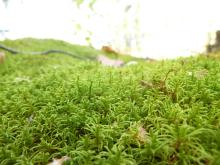





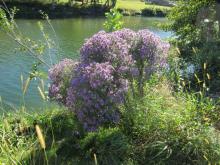
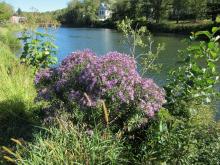

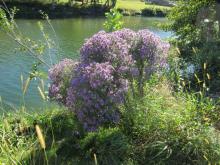


I think this is poison ivy (Rhus radicans).. is it? While it is said to occur in Alberta and in our old stomping grounds in Saskatchewan, I've never seen it before, but I'm sure lots of other forumists would recognize it instantly, if it is poison ivy...

Morning mist:
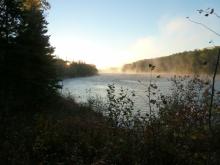
Bunchberry, Cornus canadensis, and snowberry; there were lots of colourful berries, and several little colonies of anomalous 6-leaved bunchberries:


Ground-cedar, Lycopodium complanatum:

Caribou moss (actually a lichen, Cladina stellaris), with kinnikinnick and blueberries:
